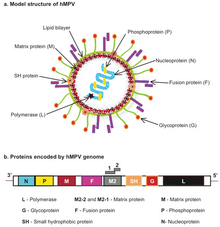
Back فيروس بشري تالي لالتهاب الرئة Arabic الفيروس التالى لالتهاب الرئة البشريه ARZ İnsan metapnevmovirusu Azerbaijani হিউম্যান মেটাপনিউমোভাইরাস Bengali/Bangla Humanes Metapneumovirus German Ανθρώπινος μεταπνευμονοϊός Greek Metapneumovirus humano Spanish متاپنوموویروس انسانی Persian Human metapneumovirus HE ह्यूमन मेटान्यूमोवायरस (HMPV) Hindi
| Human metapneumovirus | |
|---|---|

| |
| Human metapneumovirus (hMPV) structure and genome | |
| Virus classification | |
| (unranked): | Virus |
| Realm: | Riboviria |
| Kingdom: | Orthornavirae |
| Phylum: | Negarnaviricota |
| Class: | Monjiviricetes |
| Order: | Mononegavirales |
| Family: | Pneumoviridae |
| Genus: | Metapneumovirus |
| Species: | Metapneumovirus hominis
|
Human metapneumovirus (HMPV or hMPV) is a negative-sense single-stranded RNA virus of the family Pneumoviridae and is closely related to the avian metapneumovirus (AMPV) subgroup C. It was isolated for the first time in 2001 in the Netherlands by using the RAP-PCR (RNA arbitrarily primed PCR) technique for the identification of unknown viruses growing in cultured cells.[1] As of 2016, it was the second most common cause—after respiratory syncytial virus (RSV)—of acute respiratory tract illness in otherwise-healthy children under the age of 5 in a large US outpatient clinic.[2]
The peak age of hospitalization for infants with HMPV is between 6 and 12 months, slightly older than the peak of RSV, which is around 2 to 3 months. The clinical features and severity of HMPV are similar to those of RSV. HMPV is also an important cause of disease in older adults and infants.
As of December 2024[update], an outbreak of HMPV is in progress in China.[3]
- ^ van den Hoogen, Bernadette G.; Jong, Jan C. de; Groen, Jan; Kuiken, Thijs; Groot, Ronald de; Fouchier, Ron A.M.; Osterhaus, Albert D.M.E. (2001). "A newly discovered human pneumovirus isolated from young children with respiratory tract disease". Nature Medicine. 7 (6): 719–724. doi:10.1038/89098. PMC 7095854. PMID 11385510.
- ^ Williams, John V.; Harris, Paul A.; Tollefson, Sharon J.; Halburnt-Rush, Lisa L.; Pingsterhaus, Joyce M.; Edwards, Kathryn M.; Wright, Peter F.; Crowe, James E. Jr. (2004-01-29). "Human Metapneumovirus and Lower Respiratory Tract Disease in Otherwise Healthy Infants and Children". New England Journal of Medicine. 350 (5): 443–450. doi:10.1056/nejmoa025472. ISSN 0028-4793. PMC 1831873. PMID 14749452.
- ^ "HMPV is here: India detects its first case in Bengaluru with 2 cases from Karnataka". The Economic Times. 2025-01-06. ISSN 0013-0389. Retrieved 2025-01-06.